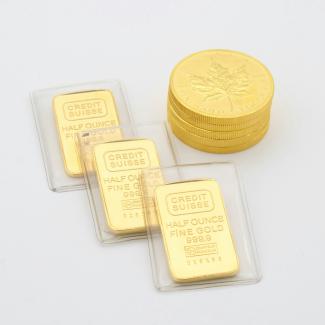
The Strategic Role of Gold in Modern Investment Portfolios
A Beginner’s Guide to Understanding Gold as an Investment
Introduction
When you’re new to investing, you might think it’s all about stocks and bonds. But there’s another player that deserves your attention: gold. This shiny metal has been valued by people for thousands of years, not just for making jewelry but as a way to preserve wealth when times get tough.
As we make our way through 2025, understanding how gold fits into your investment mix is more important than ever. Recent numbers from the World Gold Council show that people are still very interested in gold, with the first three months of 2025 seeing the highest demand for a first quarter since 2016 – about 1,206 tonnes. That’s a lot of gold!
In this guide, we’ll explore in simple terms why you might want to include gold in your investments, what risks to watch out for, and how much gold might be right for you. We’ll also look at other investment options beyond the usual stocks and bonds.
Why Consider Adding Gold to Your Investments?
1. It Helps Spread Your Risk
Think of gold as the independent friend in your group who doesn’t follow the crowd. When stocks and bonds are having a bad day, gold often isn’t affected in the same way. According to the World Gold Council’s 2025 analysis, gold can help your investments in three main ways: it can deliver good returns over time, it can improve how your investments work together, and it’s easy to sell when you need cash. This independence makes gold valuable for balancing your investment mix.
2. It Can Protect Against Rising Prices
Remember when a gallon of milk cost a lot less than it does today? That’s inflation at work. Gold has historically been good at maintaining its value even as prices rise. In 2025, gold continues to serve as a protection against both weakening currencies and market uncertainty. Investment experts at J.P. Morgan Research describe gold’s behavior as having a “smile profile” – it tends to do well in both good and bad economic conditions, just for different reasons.
3. It Often Does Well During Uncertain Times
When the economy looks shaky or there’s trouble around the world, gold often performs well. As J.P. Morgan Research notes, “Gold looks well situated to hedge the elevated levels of uncertainty around the macro landscape,” especially with potential new tariffs and policy changes that might be coming. Think of gold as a financial security blanket during stormy economic weather.
4. It’s Easy to Buy and Sell
Unlike buying a house or starting a business, gold is relatively easy to purchase and sell when you need to. The World Gold Council points out that gold is “a highly liquid asset, which is no one’s liability, carries no credit risk, and is scarce, historically preserving its value over time.” In plain English, that means gold is easy to convert to cash, doesn’t depend on any company or government staying solvent, and has a good track record of holding its value.
5. You Don’t Need to Trust Anyone Else
When you own physical gold, you don’t have to worry about a company going bankrupt or a government defaulting on its debts. The gold is yours, and its value doesn’t depend on someone else keeping their promises.
The Downsides of Investing in Gold
1. It Doesn’t Generate Income
Unlike stocks that might pay dividends (a share of company profits) or bonds that pay interest, gold just sits there. It doesn’t create new value while you own it. This becomes especially noticeable when interest rates are high and you could be earning money from other investments.
2. Storage and Insurance Can Be Expensive
If you buy physical gold, you need to keep it somewhere safe, like a home safe or a bank vault. This security comes with costs that can eat into any profit you might make. While gold ETFs (funds that track the price of gold) avoid these direct storage costs, they have their own fees to consider.
3. The Price Can Go Up and Down a Lot
Gold is often seen as stable over long periods, but its price can change dramatically in the short term. This can be scary if you need to sell your gold during a time when prices are down.
4. It’s Affected by Market Feelings, Not Just Facts
Gold prices can be influenced by how investors feel and what they think might happen, rather than just basic supply and demand. When people get nervous about the economy, they often buy gold, driving the price up – even if nothing has really changed about gold itself.
5. You Might Have to Pay Taxes
In many places, when you sell gold for a profit, you’ll owe capital gains taxes. If you buy physical gold, you might also have to pay sales tax or VAT. These taxes can reduce your overall return.
What Could Go Wrong? Risks to Watch Out For
Price Swings
Gold prices can change based on many factors – economic news, what central banks are doing, currency movements, and how investors are feeling. In early 2025, gold was trading at an average of US$2,860 per ounce, up 38% from the year before. That’s a big move in both directions – great if you bought before the rise, not so great if you bought at the peak.
Selling Difficulties During Bad Times
While gold is usually easy to sell, during severe market problems, it might become harder to get a good price. The gap between what buyers will pay and what sellers want can widen, potentially affecting how much you’ll receive when selling.
Government Rule Changes
Gold investments can be affected by changes in government policies, like restrictions on buying or selling gold, new rules for mining companies, or changes in taxation. These policy shifts can impact both the price of gold and how much it costs to own it.
Fake Gold
If you’re buying physical gold coins or bars, there’s a risk of counterfeits. You can reduce this risk by only buying from reputable dealers and having your gold authenticated by experts.
Currency Exchange Issues
If you buy gold in a currency other than the one you normally use, changes in exchange rates can affect your investment’s value when measured in your local currency.
How Much Gold Should You Have?
A Simple Rule of Thumb
Financial experts typically suggest putting between 5-15% of your investment money into gold. The exact amount depends on your personal situation, how comfortable you are with risk, and your financial goals. This moderate amount can give you the benefits of having gold without putting too much of your money in one place.
Recent market data shows global gold ETF holdings at around 3,235 tonnes as of December 2024, which is still 18% below their previous peak. This suggests there’s still room for more institutional investment in gold, which might help support prices as we go through 2025.
Different Approaches for Different Investors
If You’re Careful with Money or Close to Retirement:
Consider putting a bit more into gold (perhaps 10-15%) as a way to protect against market ups and downs and rising prices.
If You’re Young and Focused on Growth:
Younger investors with many years ahead might want less gold (perhaps 3-5%) and more stocks, which tend to grow more over long periods.
If You’re Worried About Inflation:
Those particularly concerned about rising prices might want to put 10-20% into gold and other investments that tend to do well during inflation.
Smart Ways to Build Your Gold Position
Buy a Little at a Time:
Instead of putting a large amount into gold all at once, consider buying small amounts regularly over time. This approach, called dollar-cost averaging, can help smooth out the impact of price changes.
Keep Your Balance:
Regularly check and adjust your investments to maintain your target gold percentage. This disciplined approach means selling some gold when prices rise significantly and buying more when prices fall, potentially improving your long-term results.
Beyond Gold: Other Investment Options to Consider
While gold plays a valuable role in a balanced investment approach, other alternative investments can complement your traditional stocks and bonds:
1. Silver and Other Precious Metals
Silver, platinum, and palladium offer similar benefits to gold but respond to different market factors because they have more industrial uses. This can add another layer of protection to your investment mix.
2. Real Estate Investment Trusts (REITs)
REITs let you invest in real estate without buying property directly. Think of them as companies that own and manage real estate for you. They typically pay regular income through dividends and can help protect against inflation, similar to gold.
3. Commodity Funds
These funds invest in basic goods that are used to make other products – things like oil, wheat, or metals. By spreading your money across multiple commodities, you can reduce the risk of any single one performing poorly.
4. Treasury Inflation-Protected Securities (TIPS)
TIPS are special government bonds designed to protect against inflation. Their value adjusts based on changes in the Consumer Price Index, which tracks the prices of everyday goods and services.
5. Cryptocurrency
While highly unpredictable and speculative, some investors put a small portion of their money into cryptocurrencies like Bitcoin as a digital alternative to gold. However, these digital assets don’t have gold’s long history and physical backing, making them much riskier.
Wrapping Up: Finding Gold’s Place in Your Financial Plan
As we move through 2025, gold continues to hold a special place in investment portfolios. The World Gold Council’s research confirms that gold’s wide range of uses – as an investment, a reserve asset for central banks, for jewelry, and in technology – contribute to its role as a strategic asset.
The right amount of gold varies for each person, but the key is seeing gold as just one piece of your overall financial strategy. Gold should work alongside your other investments rather than dominate your portfolio, offering diversification while acknowledging the metal’s limitations.
As with any investment decision, talking with a qualified financial advisor can help determine the right gold allocation for your specific situation, goals, and comfort with risk. A professional advisor can help integrate gold into your overall financial plan, ensuring your investment choices align with your long-term objectives.
Ready to Learn More?
At Financial Life Planning, we navigate and manage the world of gold and other alternative investments as part of a comprehensive investment allocation that supports a tailored strategy to your goals, objectives, and risk tolerance.
Click our “Contact Us” button now to schedule your free consultation and take the next step toward financial peace of mind.
Disclaimer: This article is for informational purposes only and does not constitute investment advice. Investing in gold and other securities involves risk, and past performance doesn’t guarantee future results. Always consult with a qualified financial advisor before making investment decisions.
Edward C. Goldstein, CFP®, MBA, President
CERTIFIED FINANCIAL PLANNER ™ Practitioner
Financial Life Planning, LLC
10,000 Lincoln Dr. East, Suite 201
Marlton, NJ 08053
Phone: 856-988-5480
Fax: 908-292-1040

